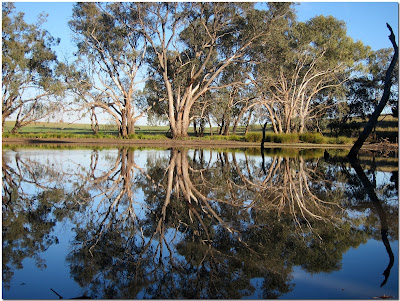The drive through Mount Kaputar National Park with its steep and winding roads really tested the torque converter. At times, we had to downshift into third gear, but the auto transmission temperature never rose above 80 degrees, so we are very happy with those figures.
Bingara is one of our favourite spots to camp, and we have been visiting here for the past ten years. Unfortunately, the rise of Wiki Camps and Camps Australia means that more people have discovered just how wonderful it is to camp along the banks of the Gwydir River. In the early days, we almost had the place to ourselves.
We have always camped east of the bridge, with campsites stretching for many kilometres, but this is the first time we have camped north of the bridge and within the town area.
Camping is now permitted in three locations, all of which border the river. We camped in the largest area, just across the river from the golf course. It was the biggest of the three, and we were fortunate to find a great spot surrounded by trees and shrubs that provided us with some privacy.
Bingara is well known for experiencing poor weather, particularly storms with hail. One only needs to look at the roofs of all the houses to realise they are all new, even in the oldest homes.
On our second night, we thought we might experience one of their storms, given the dark sky to the northeast, but then it seemed we had missed it. Early the following morning, we were awakened by the most incredible thunder and lightning show, followed by heavy rain. Our thoughts turned to several years ago when our van needed a complete reskin after a hailstorm. Fortunately, this time we escaped, although areas further north did experience hail.
After heading northeast along the road to Delungra, we joined the Gwydir Highway as we made our way towards Inverell and then on to Glen Innes, before descending the range between Washpool and Gibraltar Range National Parks.
Our campsite tonight is located at the base of the mountain, near the Cangai Bridge. As you cross the grid, you'll see a sign warning that the road ahead is unsuitable for caravans, but this only applies to the section after crossing the two bridges and reaching the camping area.
The area is quite expansive, offering views up the valley and along the Mann River. Unfortunately, once again, there were already eleven vans here when we arrived. However, it didn't really matter as we were just stopping for the evening before heading home. There are no facilities here apart from clean river water that can be used to fill your non-potable tanks. The nearest dump point is located at the caravan park in Jackadgery, where a fee of $5 is charged to empty your cassette.































